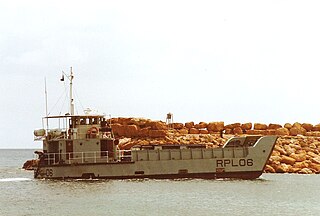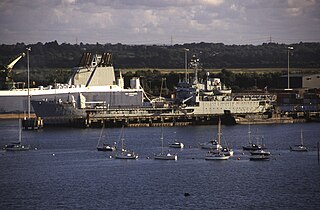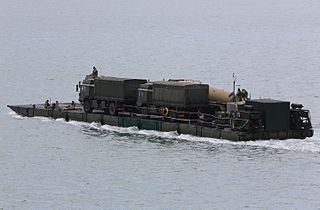
RFA Sir Galahad (L3005) was a landing ship logistics (LSL) of the Royal Fleet Auxiliary, later in service with the Brazilian Navy as the Garcia D'Avila.

HMS Intrepid (L11) was one of two Fearless-class amphibious warfare ships of the Royal Navy. A landing platform dock (LPD), she served from 1967 until 1999. Based in HM Naval Base, Devonport, Plymouth, Devon and HM Naval Base Portsmouth, she saw service around the world over her 32-year life.
HMS Leeds Castle (P258) was a Castle-class patrol vessel built by Hall, Russell & Company of Aberdeen, Scotland for the Royal Navy. She was launched in October 1980 and commissioned the following August. She was involved in the 1982 Falklands War, operating between the British territories of Ascension Island, South Georgia, and the Falkland Islands as a dispatch vessel commanded by Lieutenant-Commander Colin Hamilton.

HMS Dumbarton Castle (P265) was an offshore patrol vessel of the British Royal Navy. Her main role was the protection of the offshore assets of the United Kingdom, including oil and gas installations and fisheries out to the 200-nautical-mile limit.

The Royal Corps of Transport (RCT) was a British Army Corps established to manage all matters in relation to the transport of men and material for the Army and the wider Defence community. It was formed in 1965 and disbanded in 1993; its units and trades were amalgamated into the Royal Logistic Corps. The Depot and Training Regiment RCT was at the former Buller Barracks in Aldershot garrison.

A Landing Craft Utility (LCU) is a type of boat used by amphibious forces to transport equipment and troops to the shore. They are capable of transporting tracked or wheeled vehicles and troops from amphibious assault ships to beachheads or piers.

His Majesty's Naval Service is the United Kingdom's naval warfare and maritime service. It consists of the Royal Navy, Royal Marines, Royal Fleet Auxiliary, Royal Naval Reserve, Royal Marines Reserve and Naval Careers Service. The Naval Service as a whole falls under the command of the Navy Board, which is headed by the First Sea Lord. This position is currently held by Admiral Sir Ben Key. The Defence Council delegates administration of the Naval Service to the Admiralty Board, chaired by the Secretary of State for Defence.

The ramped powered lighter (RPL) was a type of landing craft formerly operated by the Royal Corps of Transport of the British Army, from the 1960s until the 1990s. Performing similar tasks to the ramped cargo lighter of the Second World War, it had a vehicle deck that was 5.49 metres wide and 13.26 metres long, and a load capacity of 30.5 tonnes. From the early 1980s onwards it was replaced with the larger ramped craft logistic (RCL). The last RPL was in service in Belize until the main British Armed Forces presence was withdrawn from there in 1994.
152 Regiment RLC is a Northern Irish reserve British Army regiment of the Royal Logistic Corps. The regiment is paired with the regular unit 9 Regiment RLC.

The 1982 British military campaign to recapture the Falkland Islands depended on complex logistical arrangements. The logistical difficulties of operating 7,000 nautical miles from home were formidable. The Argentine invasion of the Falkland Islands came at a time when the Royal Navy was experiencing a reduction in its amphibious capability, but it still possessed the aircraft carriers HMS Hermes and Invincible, the landing platform dock (LPD) ships HMS Fearless and Intrepid, and six landing ship logistics (LSL) ships. To provide the necessary logistic support, the Royal Navy's ships were augmented by ships taken up from trade (STUFT).

Marchwood Military Port (MMP) or Marchwood Sea Mounting Centre (SMC) is a military port located in Marchwood, Southampton on the south coast of the UK, and the base of 17 Port & Maritime Regiment Royal Logistic Corps. The port was built in 1943 to aid in the D-Day assault on Normandy in 1944 and has since been used to support the Falklands War. The port is now used largely by the Royal Fleet Auxiliary, as a base for their ships, including the Tide-class tankers, and it is also still employed for military cargo and personnel movement.

The Mexeflote is a landing raft used by the United Kingdom's Royal Logistic Corps and the Royal Australian Navy to move goods and vehicles between ship and shore. It was first used by British military in the 1960s. It was used during the Falklands War, and has been used in humanitarian aid missions. The system is very similar to the Rhino ferry.

The Landing Craft Vehicle Personnel (LCVP) is a versatile amphibious landing craft designed to transport troops or armoured vehicles from ship to shore during amphibious landings. The designation was first used in British service for the LCVP Mk2s introduced with the two Fearless class amphibious transport docks, the role having previously been carried out by the Landing Craft Assault developed during the Second World War. They are manned and operated by 1 Assault Group Royal Marines.

The ramped cargo lighter or RCL was a landing craft used in many parts of the world during the Second World War. Designed in Canada and manufactured in Vancouver and Toronto, its primary purpose was lighterage work following assault landings. The RCL also provided water transport in coastal operations. These lighters were built in sections to simplify shipping and assembled in the theatre of operations.
Ugor (PO-92) was a PO-class logistic transport ship of the Yugoslav Navy, built in 1983 and classed as an ammunition auxiliary. Later sold into merchant service, the ship traded under Montenegrin ownership with the names Kairos I and Boka Star. She was seized in 2002 by the Croatian authorities for arms smuggling and later demolished as Star.
6 Regiment RLC is a regiment of the Royal Logistic Corps of the British Army.

17 Port and Maritime Regiment is a regiment of the British Army's Royal Logistic Corps. The unit is the Army's only regular Port & Maritime capability, though it is twinned with 165 Port and Maritime Regiment RLC, of the Army Reserve.

The page contains the current structure of the British Army. The British Army is currently being reorganised to the Future Soldier structure.

MS Europic Ferry was a roll-on/roll-off car ferry built in 1967 by Swan Hunter for the Atlantic Steam Navigation Company (ASN). She was acquired by European Ferries in 1971 when they took over the ASN and served with them under the Townsend Thoresen branding. The Europic Ferry was requisitioned by the British government in April 1982 and transported stores, equipment and troops to the South Atlantic during the Falklands War. After the war she returned to service with European Ferries until that company was sold to P&O in 1987. She was sold again to Namora Shipping in 1993 and served on routes in the Mediterranean until sold for scrapping in 2004.















